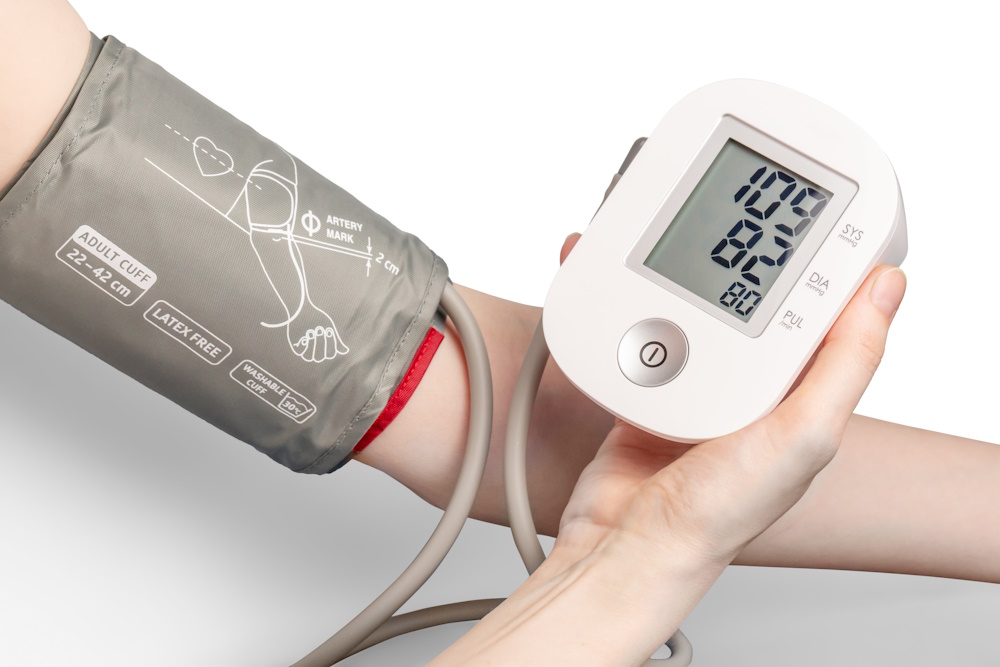The United States Department of Veterans Affairs (VA) states that high blood pressure or hypertension is common among veterans because of service-connected injuries and combat exposure. High blood pressure can cause severe consequences like strokes or heart attacks if left untreated. Thus, it’s not a condition you should ignore, and if your condition is a service-related physical disability, you might qualify for VA disability benefits.
Understanding VA Ratings for High Blood Pressure
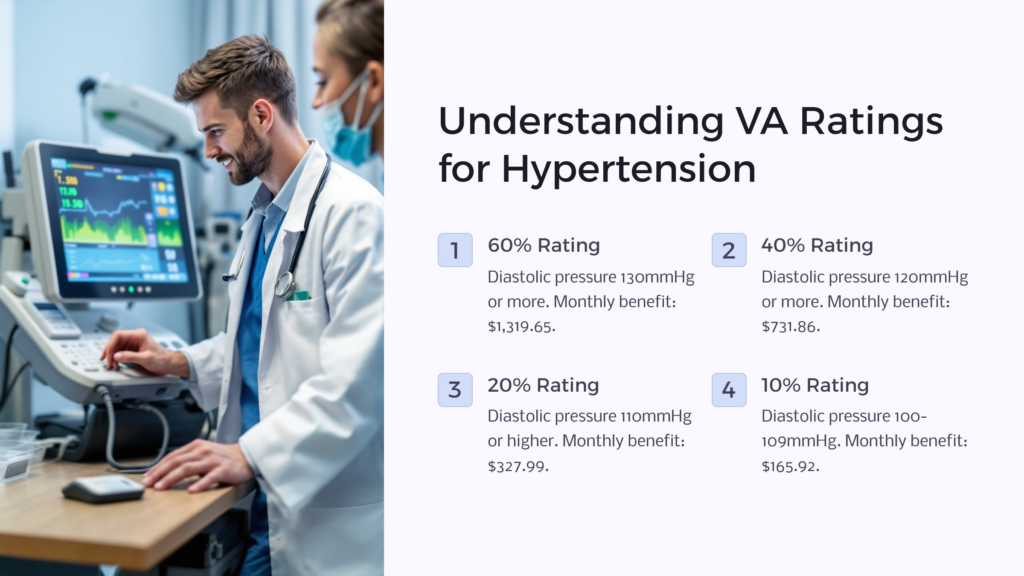
Under the Federal Schedule for Rating Disabilities, Code 7101, hypertension and isolated systolic hypertension (hypertension vascular disease) qualify for a VA disability rating.
The U.S Department of Veterans Affairs deems isolated systolic hypertension to be a systolic blood pressure that’s 160mmHg or more with a diastolic blood pressure that’s less than 90mmHg and hypertension to be a diastolic blood pressure that’s predominantly above 90mmHg.
Also, the VA requires that high blood pressure be confirmed through a blood pressure reading at least two times on at least three different days.
When you apply for VA disability benefits, the VA will assign your medical condition a VA Disability Rating. That rating is set by law and expressed as a percentage with 10% increments from 0% to 100%. It also determines the VA benefits you can receive for service-related conditions.
The VA ratings for high blood pressure range between 10% and 60%, depending on your hypertension severity. The VA uses these criteria to rate high blood pressure:
- A 60% rating is assigned if your diastolic pressure is 130mmHg or more. With this VA disability rating, a veteran receives $1,319.65 per month.
- A 40% rating is assigned if your diastolic pressure is 120mmHg or more. With this VA disability rating for high blood pressure, you’ll receive $731.86 monthly.
- A 20% VA rating is assigned if your diastolic pressure is mostly 110mmHg or higher or your systolic pressure is mainly 200mmHg or more. With this rating, you’ll receive $327.99 per month.
- A 10% VA rating is assigned if your diastolic pressure ranges between 100 and 109mmHg or your systolic pressure predominantly ranges between 160 and 199mmHg. With this rating, you’ll receive $165.92 per month.
The VA disability rating given determines your monthly disability benefits. For veterans eligible for VA disability benefits for hypertension, they must get a VA rating of at least 10%.
A 60% VA high blood pressure rating could qualify you for total disability individual unemployment (TIDU) benefits. TIDU compensates veterans who can’t work because of their service-related disabilities. Lower VA high blood pressure ratings can also be combined with VA ratings for secondary conditions or other service-related disabilities to qualify for VA disability benefits as long as the combined VA rating is at least 70% and one of the medical conditions is rated at least 40%.
Eligibility Criteria for High Blood Pressure VA Benefits
To be eligible for VA disability compensation for hypertension, your blood pressure must have a systolic pressure (top number) of 160mmHg or more or a diastolic pressure (bottom number) of 100mmHg or more.
Suppose a veteran has a valid diagnosis of high blood pressure with a diastolic pressure above 100mmHg or a systolic pressure above 160mmHg; the next requirement is to prove a definitive connection between an illness, injury, or traumatic event that occurred during military service and high blood pressure.
VA assumes a service relationship for high blood pressure if you received a medical diagnosis within one year after your release from active duty. You’ll need to prove the service relationship if you get your medical diagnosis after one year. To do that, evidence like a medical opinion or medical records will come in handy.
In addition, there are many secondary conditions the VA associates with hypertension. This includes kidney disease, ischemic heart disease, and stroke. If your hypertension is service-related and you later develop any of the above conditions as a result, you might be eligible for VA disability compensation based on a secondary service relationship.
Further, if your high blood pressure hinders your ability to sustain a regular job, you may qualify for a TIDU rating. This qualifies a veteran for the same compensation as one with a 100% VA disability rating.
To qualify for this disability rating, a veteran must prove their disability was caused by their military service with a 60% VA disability rating, making keeping steady work impossible. If you suffer from more than one disabling condition with a total disability rating of 70% or more–with at least one condition rated at 40% or more–you can also qualify for VA compensation for hypertension complications, provided by medical evidence.
The Benefits of a High Blood Pressure VA Rating
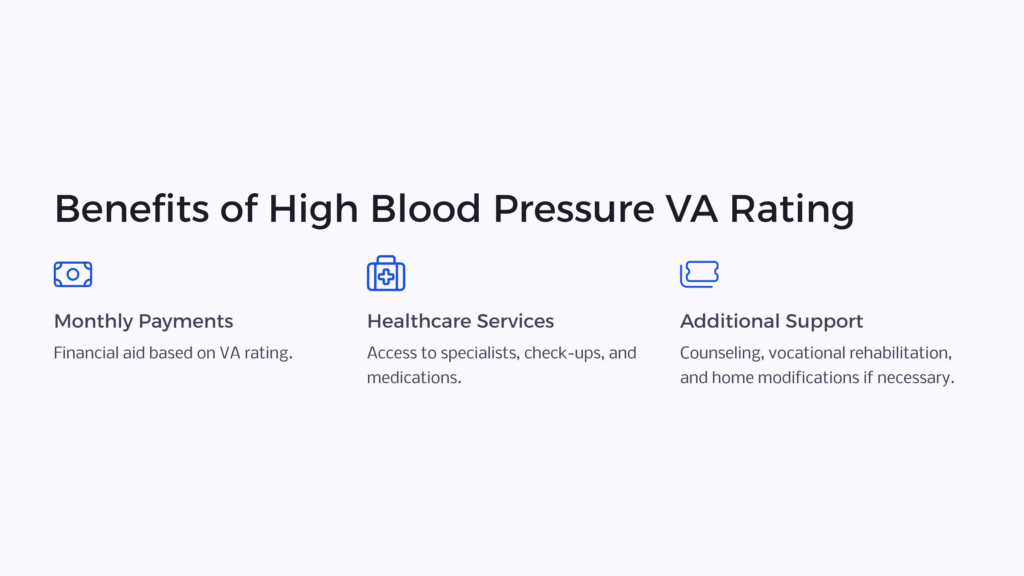
Veterans with hypertension might qualify for VA disability compensation for high blood pressure, especially if their condition is service-related. The amount of disability benefits largely depends on the assigned VA blood pressure rating. Higher VA ratings mean higher monthly benefits, offering much-needed financial aid to veterans adversely affected by their conditions.
Besides monthly payments, eligible veterans with hypertension can access healthcare services through the VA. That includes access to qualified medical specialists, regular medical check-ups, prescription medications, and regular management of their health conditions. Veterans can also get medical treatment at authorized VA clinics or through community healthcare providers, depending on their situation.
Veterans with service-related hypertension may also qualify for additional support services like counseling, vocational rehabilitation, and assistance with home modifications or adaptive equipment if necessary. These healthcare services aim to improve veterans’ overall well-being and quality of life.
The VA Claims Process for High Blood Pressure
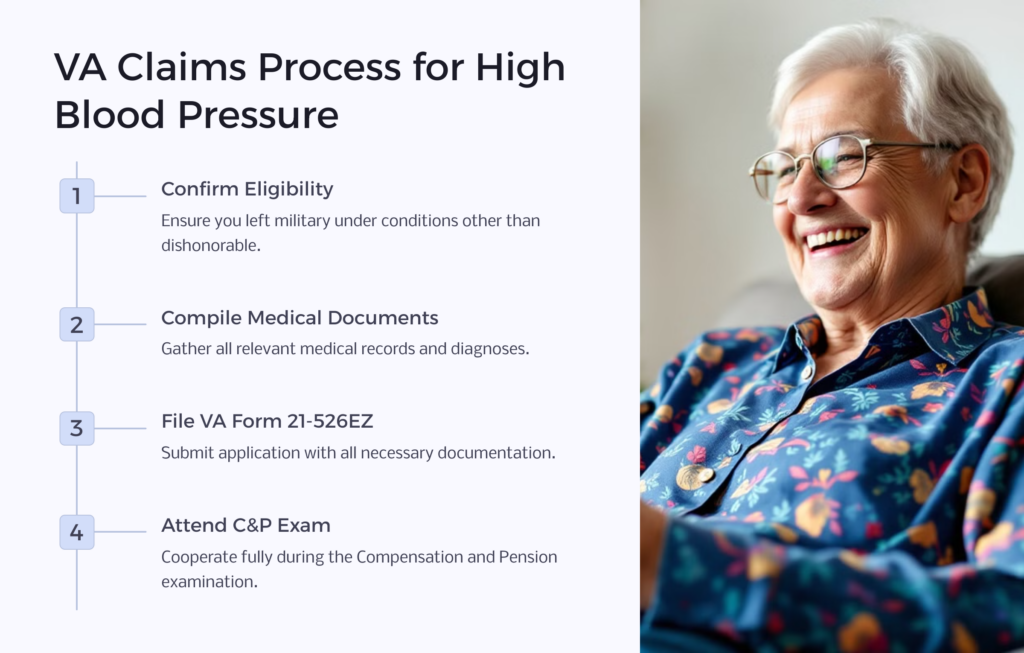
The VA recognizes hypertension as a ratable condition under its disability compensation program. The severity of your illness and its effect on your daily life influences your VA disability rating, ultimately affecting the amount of disability benefits you receive.
Here’s a step-by-step guide on how veterans can file a VA claim for hypertension:
- Confirm your compensation eligibility: To qualify for VA disability compensation, you must be a veteran who left the military under any circumstances other than dishonorable.
- Compile your medical documents: Gather all your medical records illustrating your hypertension diagnosis and its impact on your daily life. This includes medical records from authorized VA medical facilities and private healthcare providers.
- Proof of a nexus: A “nexus” connects your high blood pressure and military service. You must illustrate this connection in your VA claim, usually through service records or medical opinions showing exposure to risk factors.
- File VA form 21-526EZ: This form is also known as the “Application for Disability Compensation and Related Compensation Benefits.” This form is crucial in your journey and requires detailed military, personal, and medical information.
- Submit your VA Application: You can submit your application by mail, online, or in person at any VA regional office. Don’t forget to attach all crucial documentation, including your medical records and completed Form 21-526EZ.
- Cooperate with the Compensation and Pension (C&P) exam: Once the VA reviews your application, you may have to take a C&P exam to verify your medical condition and its severity. Be sure to attend this appointment and cooperate fully.
- Await the VA’s Decision: Once you complete your C&P exam, the VA will review your claim to establish if you meet its eligibility criteria. The high blood pressure VA claim process may take several months. During that time, be patient and respond promptly to any requests for further correspondence.
- Appeal if necessary: If you feel the VA’s decision is unfair, don’t lose hope because you can appeal that decision. However, this process requires additional evidence and can increase the decision timeframe.
Secondary Conditions and High Blood Pressure
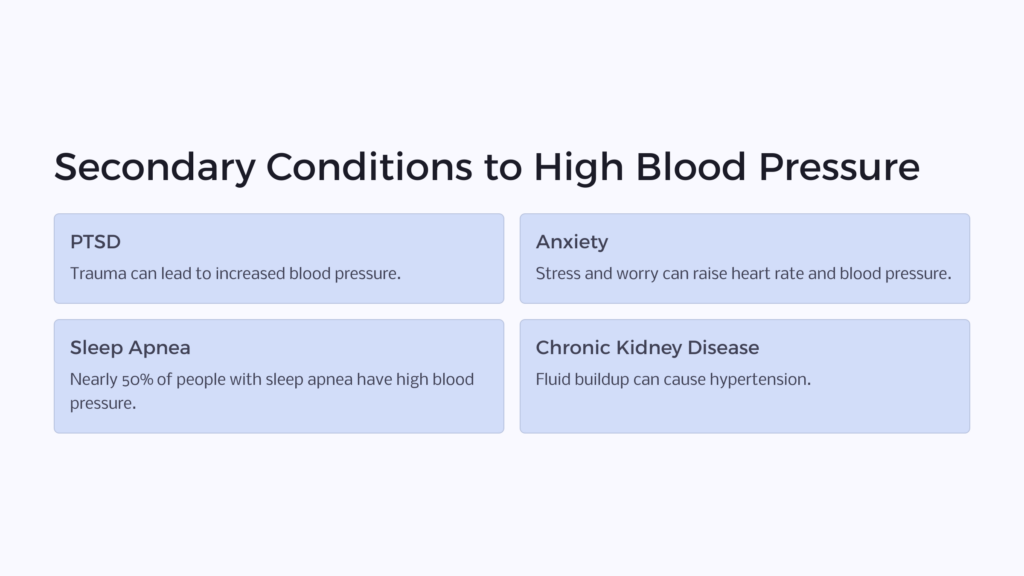
Various medical conditions are secondary to high blood pressure. Veterans can get secondary service-related disability ratings for any medical condition connected to a service-related condition. Medical evidence must show a connection between the primary and secondary service-related conditions, or the secondary condition must be related to another service-related health condition.
The following medical conditions are secondary to high blood pressure:
- Post-traumatic stress disorder (PTSD): This severe trauma disorder is common among veterans. It stems from experiencing distressing events and an incapability to process those events emotionally. A veteran with PTSD is prone to high blood pressure because of PTSD’s fear-connected symptoms like avoidance, anxiety, and hypervigilance.
- Anxiety: Veterans with anxiety are at a higher risk for high blood pressure. That’s because extreme stress, anxiety, and worry outside one’s control can raise one’s heart rate, increasing blood pressure. The link between the two conditions can work the opposite way, too. Veterans with high blood pressure might worry too much about their physical health, causing anxiety.
- Sleep apnea: This condition increases your risk of high blood pressure, with nearly 50% of people with sleep apnea suffering from high blood pressure. The link between the two is due to the stress hormones your body releases when you aren’t breathing. Those hormones increase your blood pressure because your body senses something isn’t right.
- Gout: High blood pressure is common for those with gout, a severe type of arthritis caused by too much uric acid in the blood. Uric acid crystallizes and builds up in one’s joints. The acid buildup can also cause high blood pressure. Gout is quite common among veterans.
- Chronic kidney disease: When one has chronic kidney disease, their kidneys stop removing extra fluid and waste from the blood. That excess fluid and waste causes buildup that can cause hypertension. Chronic kidney disease is also common among veterans. The VA rates kidney disease at 0, 30, 60, 80, or 100%, depending on the severity of the symptoms.
- Ischemic heart disease: This health condition is also known as coronary artery disease, and it occurs when heart arteries narrow, allowing less oxygen and blood to get to heart muscles. That causes a buildup of cholesterol in the heart arteries. High blood pressure is a significant risk factor for coronary artery disease. VA typically assigns a disability rating 0f 10, 30, 60, or 100% based on the severity.
Resources and Support for Veterans with High Blood Pressure
The VHA (Veterans Health Administration) in the United States Department of Veterans Affairs focuses on transparency and performance management and leverages that approach to ensure better care for veterans. VHA serves as a model for health care services looking to enhance patient care, including the aspect of controlling and managing high blood pressure.
VHA boasts 75% hypertension control rates among veterans. VHA’s journey to support veterans with hypertension involves longstanding efforts from teams, individuals, and support programs across all VA medical facilities and other care centers. VHA improves the well-being of veterans with hypertension by:
- Investing heavily in long-term research to speed up improvements in veterans’ well-being and healthcare
- Investing in telehealth and home-based primary healthcare initiatives to allow blood pressure monitoring at home
- Developing evidence-based healthcare practice guidelines for healthcare providers based on applicable external and internal research standards
- Putting together outreach strategies to support veterans in achieving better blood pressure control
- Improving medication adherence
Besides the VHA, the Veterans Health Library (VHL) in the U.S. Department of Veterans Affairs provides various materials on tests & treatments, rehabilitation, and medications to help veterans stay informed about their health condition.
Further, veterans who have a MyHealthVet account can access the Track Health feature and record their blood pressure readings online. Also, VA patients can refill their VA prescriptions online.
Conclusion: VA Rating for Veterans With High Blood Pressure
High blood pressure or hypertension is a health condition that can cause other severe medical conditions like stroke, heart attack, or heart disease. Veterans suffering from high blood pressure connected to their time in the military can file a VA claim for hypertension to receive a VA disability rating, entitling them to monthly benefits depending on the severity of their symptoms. For more information on VA rating for veterans with high blood pressure and help with your VA application, visit our website at Benefits.com.
 Benefits.com Advisors
Benefits.com Advisors
With expertise spanning local, state, and federal benefit programs, our team is dedicated to guiding individuals towards the perfect program tailored to their unique circumstances.
Rise to the top with Peak Benefits!
Join our Peak Benefits Newsletter for the latest news, resources, and offers on all things government benefits.















